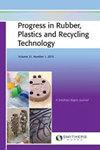Effects of waste rubber particles on workability, mechanical, and sound insulation properties of recycled aggregate mortar
IF 1.6
4区 材料科学
Q4 MATERIALS SCIENCE, COMPOSITES
Progress in Rubber Plastics and Recycling Technology
Pub Date : 2024-03-16
DOI:10.1177/14777606241239066
引用次数: 0
Abstract
The influence mechanism of waste rubber particles (WRPs) on the workability, mechanical properties, and sound insulation performance of recycled aggregate sound insulation mortar (RCM) were investigated. According to the principle of volume fraction replacement of recycled fine aggregate by 0 to 50%, WRPs with a particle size of 1–4 mm were incorporated in various mixtures of RCM. Each RCM mixture was tested for workability, mechanical, and sound insulation performance. Mercury intrusion porosimetry was used to analyze the distribution of pores and their sizes inside the material, and X-ray diffraction and scanning electron microscopy were used to analyze the characteristics of the interfacial transition zones (ITZs) between the rubber particles and the cement paste. The results showed that, owing to the hydrophobicity of WRPs, greater WRPs content led to greater fluidity of the mortar mix and a smaller water retention rate. Notably, the rubber in the mortar did not contribute to the hydration reactivity of the cement paste, but it changed the crystal morphology and pore structure of ITZ hydration products. The RCM incorporating 3–10% WRPs produced the optimal pore structure through the aggregate effect, which increased its overall compactness and mechanical performance. Further increase of WRP content significantly improved the sound insulation performance while significantly reducing the strength. Moreover, there was a clear logarithmic relationship between the strength and impact sound level index. This new knowledge can be used to prepare RCM that meets the actual strength and sound insulation requirements of the floor. Thus, the resource utilization of solid waste can be expanded.废橡胶颗粒对再生骨料砂浆工作性、机械和隔音性能的影响
研究了废橡胶颗粒(WRPs)对再生骨料隔音砂浆(RCM)的工作性、机械性能和隔音性能的影响机理。根据再生细骨料体积分数替换率为 0 至 50%的原则,在各种 RCM 混合物中掺入粒径为 1-4 mm 的废橡胶颗粒。对每种 RCM 混合物的施工性、机械性能和隔音性能进行了测试。采用汞侵入孔隙测定法分析了材料内部的孔隙分布及其大小,并采用 X 射线衍射和扫描电子显微镜分析了橡胶颗粒与水泥浆之间的界面过渡区(ITZ)的特征。结果表明,由于水溶性聚苯乙烯的疏水性,水溶性聚苯乙烯含量越高,砂浆混合料的流动性越好,保水率越小。值得注意的是,砂浆中的橡胶对水泥浆的水化反应性没有影响,但它改变了 ITZ 水化产物的晶体形态和孔隙结构。掺入 3-10% 水合反应剂的 RCM 通过骨料效应产生了最佳的孔隙结构,从而提高了其整体密实度和机械性能。进一步增加 WRP 含量可明显改善隔音性能,同时显著降低强度。此外,强度与冲击声级指数之间存在明显的对数关系。这一新知识可用于制备符合地板实际强度和隔音要求的 RCM。因此,可以扩大固体废物的资源利用。
本文章由计算机程序翻译,如有差异,请以英文原文为准。
求助全文
约1分钟内获得全文
求助全文
来源期刊

Progress in Rubber Plastics and Recycling Technology
MATERIALS SCIENCE, COMPOSITES-POLYMER SCIENCE
CiteScore
4.40
自引率
7.70%
发文量
18
审稿时长
>12 weeks
期刊介绍:
The journal aims to bridge the gap between research and development and the practical and commercial applications of polymers in a wide range of uses. Current developments and likely future trends are reviewed across key areas of the polymer industry, together with existing and potential opportunities for the innovative use of plastic and rubber products.
 求助内容:
求助内容: 应助结果提醒方式:
应助结果提醒方式:


